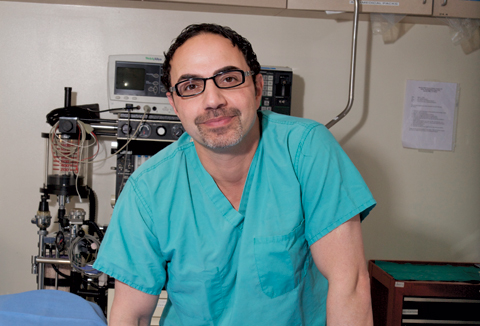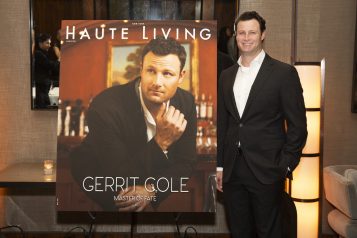Photography by Laura Wagner
Well-done liposuction is about proper judgment and perfect technique.
In the United States, liposuction is the most frequently performed cosmetic surgery. It is also one of the most commonly redone surgeries, with an approximate 25 percent revision rate. Amidst the glitz and glam of Beverly Hills, one dermatologic surgeon is cutting through the fat and providing solutions for patients who find themselves with less-than-desirable liposuction results.
As a liposculpture specialist, Dr. David M. Amron has perfected his unique technique over the past 14 years. He is sought out by patients across the globe, not only because of his artistic appreciation for his craft, but also for his thorough approach, perfectionistic eye for detail, and expertise in correcting the most challenging cases of revision liposuction surgery.
With a background in dermatology, Dr. Amron is armed with an in-depth understanding of the skin and how it best responds to this cosmetic procedure. He is a purist, forgoing trendy technologies of melting fat in favor of the tactile sensation of reducing the amount of fat using his own judgment and expertise. For these reasons he is extensively featured on television networks such as CNN, BBC America, and Discovery Health, and in print publications like The Wall Street Journal, People, and Comsopolitan. In this latest edition of Haute MD, the revered dermatologic surgeon, who Entertainment Tonight calls the “Guru of Liposuction,” offers his insights into America’s favorite cosmetic surgery.
HAUTE LIVING Tell us a little about your approach to liposuction surgery.
Dr. David Amron Liposuction surgery is the only major cosmetic surgery that I perform and I believe in getting it right the first time. I think this is an important factor to consider when choosing a cosmetic surgeon, because it is difficult to be a jack-of-all-trades. By limiting my menu of services, it allows me to hyper-focus on my specific liposuction technique. My whole philosophy is based on balancing and creating the proper proportion. Liposuction is a surgery that should be reserved only to target areas of genetic disproportion. Who is a good candidate has little to do with being overweight or out of shape. These are the patient’s responsibility. Mine is to balance and contour their body. The way that I do this is under a local anesthesia with a method I call “pure tumescent liposuction,” originally developed by dermatologic surgeons. I prefer to keep the patient awake during the surgery because it is crucial to have them in the most perfect position while I am contouring and sculpting. When the patient is awake, they are an active participant in their own results. Under general anesthesia the patient can only lie there, with loose muscle tone, and there’s no way to accurately contour the targeted areas. A conscious patient can adjust and shift their body, working with me as I precisely sculpt each area.
With regard to the contouring and sculpting, as far as my own personal technique, it isn’t something I visually see as much as something that I feel. It is a very tactile surgery. My approach, which I’ve refined over the years, starts deep in the fat layer with small, round instruments. I gradually move up in the fat layer creating thousands of tunnels. Then I finish off at the surface, just under the skin, with a flat tipped spatula cannula that allows me to ensure that the surface is completely smooth and there are no irregularities. I’m also careful as I’m doing the contouring to never poke, jab, or tent the skin from underneath, which I can only accomplish by optimal positioning of a conscious patient. In addition, I also control exactly the amount of skin retraction I want to get.
HL You are not a proponent of certain technological trends in the industry which
claim to melt away fat. Why?
DA One of the problems that I have with some of the newer technologies in the industry, such as lasers and ultrasounds that some doctors boast can melt fat away faster, is that people are putting a lot of trust in the machine and not necessarily in the person behind the machine. That is not what that is about for me. Well-done liposuction is about proper judgment and perfect technique. It is always about the surgeon’s hands, eyes, judgment, and artistry behind the tools. I find that liposculpture is such a tactile procedure that I don’t trust the aspect of just melting fat. I want to feel exactly how much I’m bringing the areas down.
HL Approximately 40 percent of the surgeries you perform are revision work, repairing or improving on the results done previously by other surgeons. What are some of the most common mistakes that you see?
DA Most often I see patients who have been thrown out of balance and proportion. Frequently patients undergo liposuction surgery for the wrong reasons, such as being overweight, but really, liposuction is a tool to target areas of genetic disproportion. It is a balancing procedure, so for most revision surgeries that I do, my role is to rebalance the body. Sometimes the first liposuction was not done aggressively enough. That is fairly easy to adjust by going back in and bringing the area down more. Sometimes the areas were not blended well with the surrounding areas so there can be drop offs or shelves, creating an unnatural look to the border of the liposuction. In those cases I will go in and blend the areas and smooth things out. I think that one of the biggest mistakes I encounter are surgeons that were too aggressive. Often they dive in and approach it from the standpoint of just sucking fat out. But there is so much more to it than just sucking fat out. It really is very artistic. And that is a big area of my revision work-treating areas of the skin that have a lot of unevenness. There can be ripples, dents, or pockets of fat remaining-basically just a lot of irregularities. It is one of the most challenging areas to approach with a liposuction surgery revision.
HL What advice do you have for prospective patients in order to ensure that surgery revision will not be needed?
DA Obviously checking board certification is essential, but another important thing is to pay close attention to the consultation itself. Choose several doctors to consult with and get different opinions. Take your time and see how complete and comprehensive the doctor is being. If you feel like you’re being rushed, it could be a red flag. If you feel like you’re being sold to as opposed to educated and guided, to me that is also a red flag. I really try to approach the patient with complete integrity and I think that makes all the difference in the world.





















